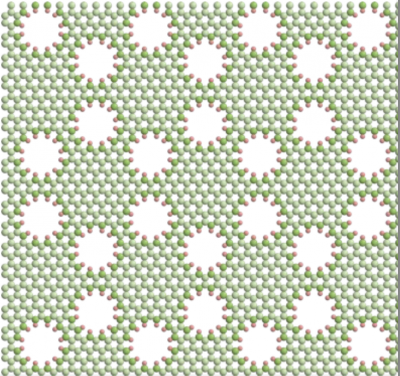Explore recent research led by Prof. Amir Haji-Akbari's team, elucidating the critical impact of precise pore placement in nanoporous membranes. Their study, published in ACS Nano, challenges conventional understanding and offers insights into optimizing membrane designs for enhanced permeability and selectivity.

Image Credit: Yale University
In recent years, nanoporous membranes comprised of graphene, polymers, silicon, and other materials have been effectively employed for gas separation, water desalination, virus filtering, power production, gas storage, and medicine delivery. However, developing membranes that allow all the proper molecules to flow through while keeping the wrong ones out has been difficult.
For desalinating water, for example, the membrane must be highly permeable to water while inhibiting tiny ionic and molecular solutes and other contaminants. However, researchers discovered that increasing a membrane’s permeability typically reduces its selectivity, and vice versa.
One viable strategy is to tailor the chemistry and geometry of isolated nanopores to obtain the necessary permeability and selectivity, then embed as many of those holes as feasible in a nanoporous membrane. The exact mechanism by which nearby pores interact is unknown.
At the nanoscale, molecules interacting with pore walls can display behaviors contradicting traditional beliefs. The Haji-Akbari lab investigated if nanopore fine-tuning might be used to create new membrane systems with enhanced accuracy and efficiency.
Haji-Akbari’s study team discovered that nanoscale proximity between pores might negatively impact salt rejection and water permeability using computer simulations. They specifically created simulations of membranes with different pore placement patterns, such as a honeycomb and hexagon lattice.
They discovered that the membrane with the hexagonal pattern performed better in terms of permeability and selectivity than the one with the honeycomb pattern because it allowed for wider spacing between pores.
These consequences, according to Haji-Akbari, depart from accepted hypotheses.
This assumption that the pore resistance is independent of the proximity of the pore is not correct. Clearly, it depends on proximity.
Amir Haji-Akbari, Assistant Professor, School of Engineering & Applied Science, Yale University
Their results provide insight into how these factors cause some ions to flow across membranes more quickly than others while slowing down other ions. Additionally, it can guide the development of improved nanoporous membrane designs for improved separation procedures like water desalination and other uses.
Journal Reference:
Shoemaker, B. A., et. al. (2024) Correlations in Charged Multipore Systems: Implications for Enhancing Selectivity and Permeability in Nanoporous Membranes. ACS Nano. doi:10.1021/acsnano.3c07489.